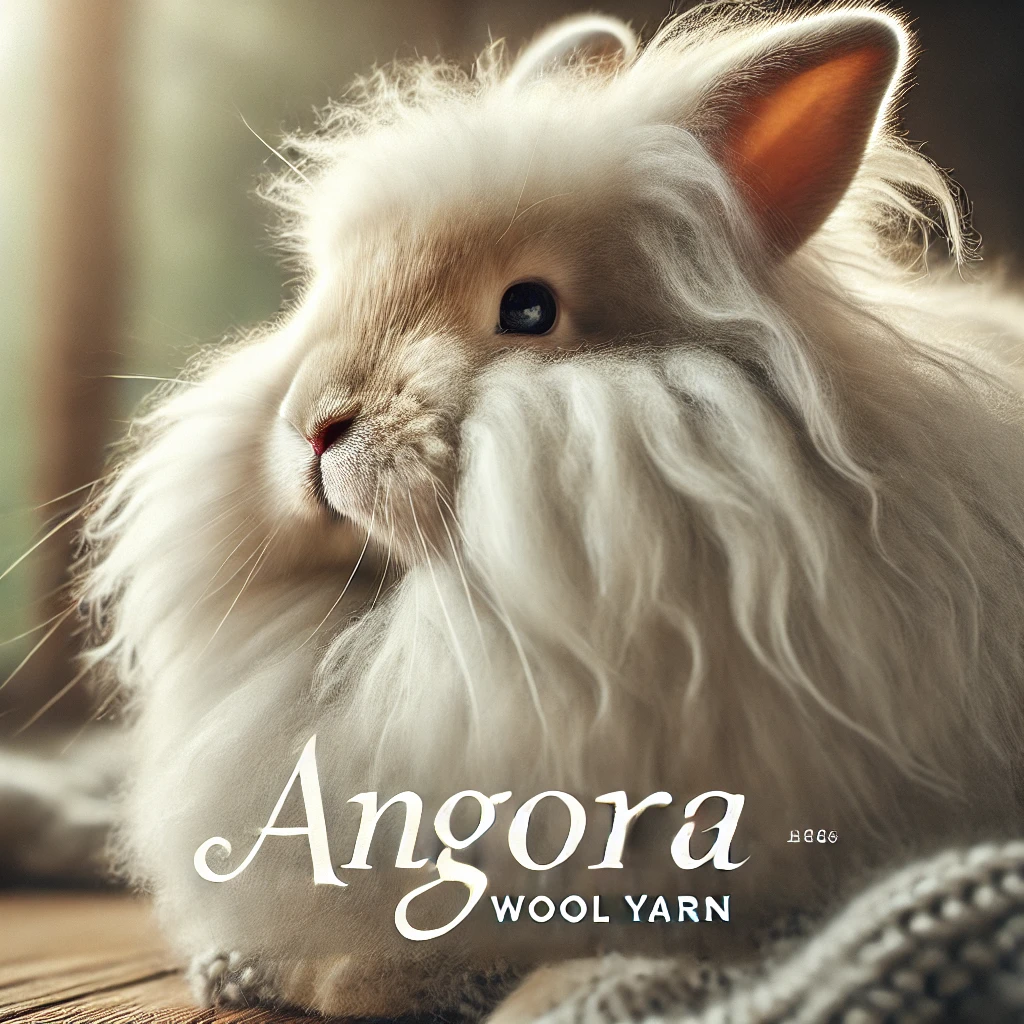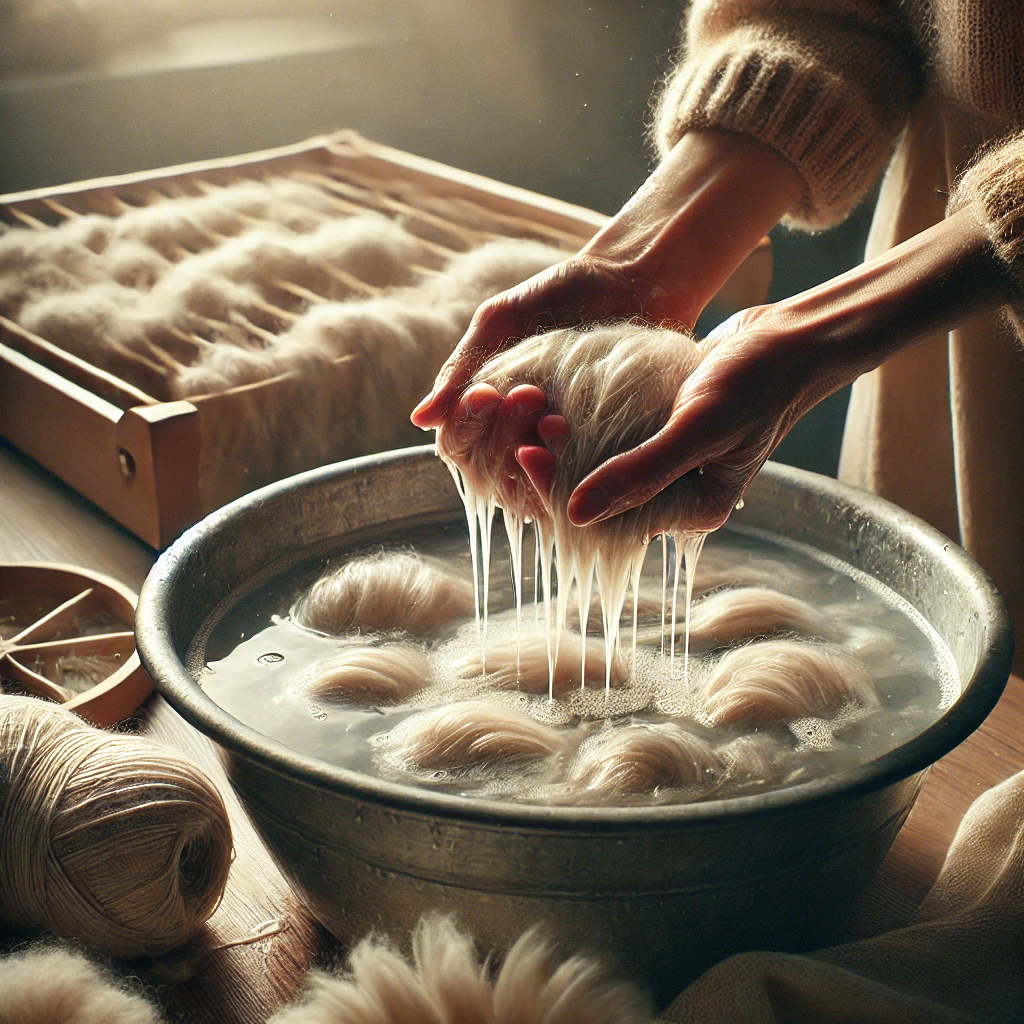Angora wool yarn is a luxurious and highly sought-after fiber, cherished by spinners and knitters alike for its warmth, softness, and beautiful halo effect. Derived from the fur of Angora rabbits, this yarn offers unique properties that make it a favorite for creating cozy garments and accessories. Whether you’re new to angora wool or a seasoned crafter, this guide will provide you with everything you need to know—from the characteristics of Angora wool to spinning, dyeing, and caring for this delicate fiber.
What is Angora Wool Yarn?
Angora wool comes from Angora rabbits, a breed known for producing fine, warm, and fluffy fibers. This wool is much lighter and up to 7-8 times warmer than sheep wool, making it an excellent choice for winter wear. Angora wool fibers are incredibly soft, with a micron count between 10 and 15, which is even finer than Merino wool.
What makes Angora wool truly special is its halo effect—a light, fluffy layer that forms around the yarn. This halo becomes more prominent as the wool is spun, knitted, and worn, giving garments made from Angora wool a unique, ethereal appearance.
There are five main breeds of Angora rabbits, each offering different textures and characteristics:
- French Angora: Known for its rich color and spiky halo.
- Giant Angora: A breed that produces the largest quantity of fiber.
- English Angora: Extremely fine fibers with nearly invisible guard hairs.
- Satin Angora: Recognized for its silky sheen.
- German Angora: Produces fiber with a consistent crimp and is one of the most productive breeds.
Properties of Angora Wool
Angora wool is a dream to work with due to its unique properties:
- Softness: Angora wool is incredibly soft, even more so than many luxury fibers. The fine texture of the wool makes it ideal for garments worn close to the skin, like scarves and shawls.
- Warmth: Angora is one of the warmest fibers available, making it perfect for cold-weather clothing. However, because it is so warm, it’s best to spin it fine to avoid overheating.
- Halo Effect: One of the defining features of Angora wool is the halo, which gives the yarn a light, airy appearance. This effect is enhanced when the yarn is spun and knitted.
- Hydrophobic Nature: Angora wool resists water absorption, which makes it tricky to wash or dye. Careful handling is required to ensure it absorbs water without damaging the fibers.
Washing & Care Advice for Angora Wool
Due to its hydrophobic nature and delicate structure, Angora wool requires special care when washing. Here’s how to properly wash Angora wool yarn to maintain its softness and halo:
- Use lukewarm water: Submerge the wool in lukewarm water to avoid damaging the fibers.
- Squeeze gently: Instead of wringing the wool, press it gently to allow water to pass through the fibers. Angora wool can float on water for hours without absorbing it, so it may need a bit of help.
- Avoid agitation: Agitating the wool can cause felting. Be gentle with the fibers to prevent damage.
- Air dry flat: Lay the wool flat to dry naturally, avoiding direct sunlight or heat sources.
Spinning Angora Wool Yarn
Spinning Angora wool can be a bit challenging at first due to its slick texture. The scales on Angora fibers are smoother than those of wool, which can make them feel “slippery.” To overcome this, you need to add more twist to your yarn during the spinning process. Here are some tips for spinning Angora wool:
- Spin fine: Angora wool is very warm, so spinning it into fine yarn is recommended to avoid making overly hot garments.
- Add an extra twist: Because of its smooth texture, adding more twist to Angora wool will help create a stable yarn that holds together well.
- Use a light spindle: If you’re using a drop spindle, choose a lighter one for spinning fine yarns. A lighter spindle with a smaller whorl is ideal for lace-weight yarns.
- Practice makes perfect: Spinning Angora wool takes practice, but once you get the hang of it, spinning other fibers will feel easier.
Blending Options for Angora Wool
While pure Angora wool is luxurious, blending it with other fibers can add durability and introduce different properties to the yarn. Here are some excellent blending options:
- Silk: Adding silk to Angora produces a strong yarn with a beautiful sheen and a good drape. Silk also absorbs dye better, making it a great choice if you plan on dyeing your yarn.
- Fine Wool: Blending Angora with fine wool such as Merino, Cormo, or Rambouillet adds elasticity and spring to the yarn. This combination is perfect for projects that require a bit more stretch and durability.
- Alpaca: Like Angora, alpaca is soft, and warm and develops a halo. Combining the two fibers will enhance the softness and stretch your Angora further without sacrificing warmth or softness.
Fiber Quality & Shearing Techniques
Angora fiber can be harvested through two primary methods—plucking or shearing—depending on the breed of rabbit. Both methods can produce high-quality fiber, but there are important factors to consider.
- Plucked Fiber: Plucked Angora wool comes from rabbits that naturally molt. This method produces clean fiber with consistent lengths, which is ideal for spinning fine, even yarn. However, plucking is only suitable for certain Angora breeds.
- Sheared Fiber: Shearing is required for breeds like the German Angora, which continuously grows fiber. Shearing doesn’t necessarily produce inferior quality, but it can make shorter fibers more prone to shedding. Be sure to check for fiber quality before purchasing sheared Angora wool.
Prime Angora fiber should be 2.5 to 3.5 inches long, free of stains, vegetable matter, and matting. Fiber from a well-maintained rabbit will be clean and ready to spin right off the animal’s back without washing.
Fiber Preparation for Spinning
Since Angora rabbits do not produce lanolin, their fiber is 97% pure when harvested. This means that it doesn’t require extensive cleaning before spinning. The only contamination you might find is a small amount of dander, which can be washed away using warm water and mild dish soap.
There are various methods to prepare Angora for spinning:
- Teasing into a cloud: Grab a small handful of Angora wool gently tease it into a cloud-like mass. Spinning from a cloud is easy and results in a woolen yarn with a bit more halo.
- Hand carding: Use hand carders to gently prepare the fiber. Don’t overload the cards, as this can damage the delicate fibers. After carding, you can remove the “mini batt” and spin as you would with a drum-carded batt.
- Spinning from the cut end: Some spinners prefer to spin directly from the cut end of the fiber, which allows for smoother drafting. Try both the tip and cut end to see which method works best for you.
Knitting with Angora Wool Yarn
Knitting with Angora wool yarn is a delight, thanks to its softness and lightness. However, because Angora wool is so warm, it’s best to use it for lightweight garments like shawls, gloves, and scarves. Thick, worsted-weight Angora garments may be too warm, even for winter use.
- Fine patterns: Stick to lightweight knitting patterns to avoid creating garments that are too warm.
- Simple stitch designs: The halo effect of Angora adds texture to your work, so simple stitch patterns often work best. Complex stitch patterns may get lost in the fuzziness of the yarn.
Yarn Dyeing for Angora Wool
Due to its hydrophobic nature, dyeing Angora wool requires special techniques to ensure the fiber absorbs the dye evenly. Here’s how to dye Angora wool yarn:
- Pre-soak the fiber: Before dyeing, immerse the Angora wool in lukewarm water mixed with a little mild detergent. This allows the fibers to absorb the dye more uniformly.
- Use acid-based dyes: Protein fibers like Angora wool take acid-based dyes well. For optimal results, follow the instructions provided by the dye manufacturer.
- Rinse with cold water: After dyeing, rinse the yarn thoroughly in cold water to set the dye.
Finishing Angora Yarn
Once you’ve spun your Angora yarn, the final step is to finish it to set the twist and encourage the halo to bloom. Here’s a simple method for finishing Angora yarn:
- Skein the yarn: Secure the skein in several places to prevent tangling.
- Wash in warm water: Use a little dish soap and let the yarn soak for 2-5 minutes.
- Cold rinse with vinegar: After washing, rinse the yarn in cold water mixed with a small amount of vinegar to set the twist.
- Snap and thwack: After washing, gently snap the yarn to even out the twist. You can also thwack the yarn against a hard surface to help the fibers bloom.
Conclusion
Angora wool yarn is a versatile and luxurious fiber with a unique combination of warmth, softness, and beauty. Whether you’re spinning, knitting, or dyeing Angora wool, taking the time to understand its properties and care will allow you to create stunning, high-quality garments. By following these tips and techniques, you’ll be able to make the most of this remarkable fiber and enjoy working with it for years to come.





Leave a Reply